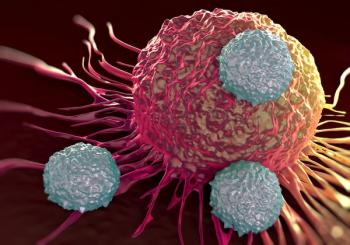
Oncology NEWS International
- Oncology NEWS International Vol 11 No 5
- Volume 11
- Issue 5
Experts Show How to Combat Fatigue With Exercise, Nutrition
NEW YORK-Sipping smoothies, exercising, and keeping a journal are among the things cancer patients can do to combat fatigue and build energy, according to Eileen Donovan, PT, MEd, manager of rehabilitation services at The University of Texas M. D. Anderson Cancer Center, and Marilyn Joyce, RD, a Los Angeles-based nutritionist and author. Both women spoke at a Cancer Care teleconference about the role of exercise and nutrition in coping with fatigue.
NEW YORKSipping smoothies, exercising, and keeping a journal are among the things cancer patients can do to combat fatigue and build energy, according to Eileen Donovan, PT, MEd, manager of rehabilitation services at The University of Texas M. D. Anderson Cancer Center, and Marilyn Joyce, RD, a Los Angeles-based nutritionist and author. Both women spoke at a Cancer Care teleconference about the role of exercise and nutrition in coping with fatigue.
Even relatively short periods of bed rest can cause changes in a person’s physical conditioning and a decline in energy, they noted. Whether starting a formal exercise program or just increasing activity, a patient should always seek a physician’s advice, she said. If there is bone disease, certain activities should be avoided, or if someone is unable to perform the basic activities of daily living, a referral to a physical or occupational therapist may be necessary.
Appropriate Exercise Goals
What kind of exercise is needed and how much? "What is appropriate for someone who is still working, even though they may feel quite fatigued, is very different from what is appropriate for someone who gets tired just walking to the bathroom," Ms. Donovan said.
The question turns on whether the exercise is meant to increase strength, endurance, and stamina or to increase the strength of a specific muscle group.
Ms. Donovan said that many patients who complain about feeling weak often have normal muscle power, and their problem seems to be endurance. Others may have a specific muscle weakness. A physical therapist, occupational therapist, or physical medicine physician can help sort out the reasons and recommend exercises, equipment, or other strategies.
Many patients first realize they are losing strength when they have trouble getting up from a low chair or from the toilet, Ms. Donovan said. If the problem is related to the leg muscles, one strategy, she suggests, is to find a chair the patient can get up from without much difficulty and have him or her practice getting up from it several times a day. "After a week, I may ask them to find a chair that is just an inch or so lower and to practice getting up from that chair several times a day," she said.
In general, patients should start exercising at the baseline of what they are able to do and increase it a little each week, either by increasing how much they do or how strenuously they do it.
"A person might know they can comfortably walk a certain distance in 10 minutes. That would be their starting point," Ms. Donovan said. "They might walk this distance for 10 minutes, three times a week for a week. The next week, they might walk faster so they walk further in that 10 minutes. Or they might walk the same speed but walk for 11 or 12 minutes, increasing the duration of exercise. Increase either the intensity or the duration, but not both at the same time."
Walking is a very good exercise because it is rhythmic, uses large muscle groups, does not take equipment, and can be done by most people even if they have to start by walking from the bed to the bathroom and back, Ms. Donovan said. But for a very weak and deconditioned person, just sitting on the edge of the bed for a few minutes may be enough exercise to start, she added.
She suggests that patients keep an activity journal in which they jot down what they did and how they felt when they did it. "If you experienced any exercise-related symptoms, jot them down," she said. "As you keep this journal, you will be able to track your progress and note any patterns. For instance, you may find that you always have to stop and rest more frequently when you exercise at a certain time of the day or at a certain time in your treatment cycle."
Pacing oneself is also very important, even if the new exercise is just getting up to change the TV channel instead of using the remote, she said.
Patients should start at a low intensity with rest periods, increasing only gradually, and stop if they experience new or increased bone or joint pain, new muscle weakness, nausea, or a sudden shortness of breath or chest pain during exercise. They should not exercise if they are receiving intravenous chemotherapy, have fever, or have had severe nausea, vomiting, or diarrhea during the past day.
Nutritious Smoothie
Nutritionist Marilyn Joyce provided ONI with this recipe for a nutritious smoothie excerpted from her book I Can’t Believe It’s Tofu! (see
Blend the following ingredients in a blender until smooth:
4 oz (½ cup) soft tofu
½ cup frozen strawberries
4 oz (½ cup) vanilla soy milk
1 large banana
Other fresh fruits in season can be used. Regular milk can be used instead of soy milk.
And when fatigued patients have an appetite, they may reach for the wrong thing, Ms. Joyce warned. "Often, when we are going through this fatigue, we grab whatever we can get. We may crave the comfort foods that are high in sugar and loaded with hydrogenated fats."
The key problem with this is that these foods actually prevent the body from producing energy by destroying the nutrients essential for the production of energy. "The B vitamins, vitamin C, and many other nutrients are inherently destroyed by the simple carbohydrates or sugars that are found in fast foods like sodas, cookies, and candies," Ms. Joyce said.
Many of her clients tell her they have an occasional glass of wine or alcohol because they feel fatigued, frustrated, or uptight. The problem is that alcohol turns to sugar immediately and has the same effect of destroying these vitamins and preventing absorption of essential minerals. She recommends that, when they have the energy, patients should make up big batches of brown rice, vegetarian chili, salmon loaf, sliced or chopped raw vegetables, vegetarian stews, vegetable and legume soups, dipsand smoothies.
Articles in this issue
over 23 years ago
Prognosis Good for Local Recurrence After Lumpectomyover 23 years ago
Long-Term Use of Actiq Safe and Effective for Breakthrough Painover 23 years ago
Youth Exposed to Tobacco Promotionsover 23 years ago
Green Tea May Help Prevent Certain Gastrointestinal Cancersover 23 years ago
EGFR Inhibitor Effective as Salvage Therapy for NSCLCover 23 years ago
Targeted Filgrastim Support Allows Planned Chemotherapy Dosesover 23 years ago
Low Risk of CHF With Paclitaxel/Trastuzumab Adjuvant Rxover 23 years ago
Anxiety, Depression in Women at High Risk for Breast Cancerover 23 years ago
NCCN Updates its Treatment Guidelines for Breast Cancerover 23 years ago
Danny Glover ‘Acting’ as Spokesman for Anemia LifeLineNewsletter
Stay up to date on recent advances in the multidisciplinary approach to cancer.
















































































